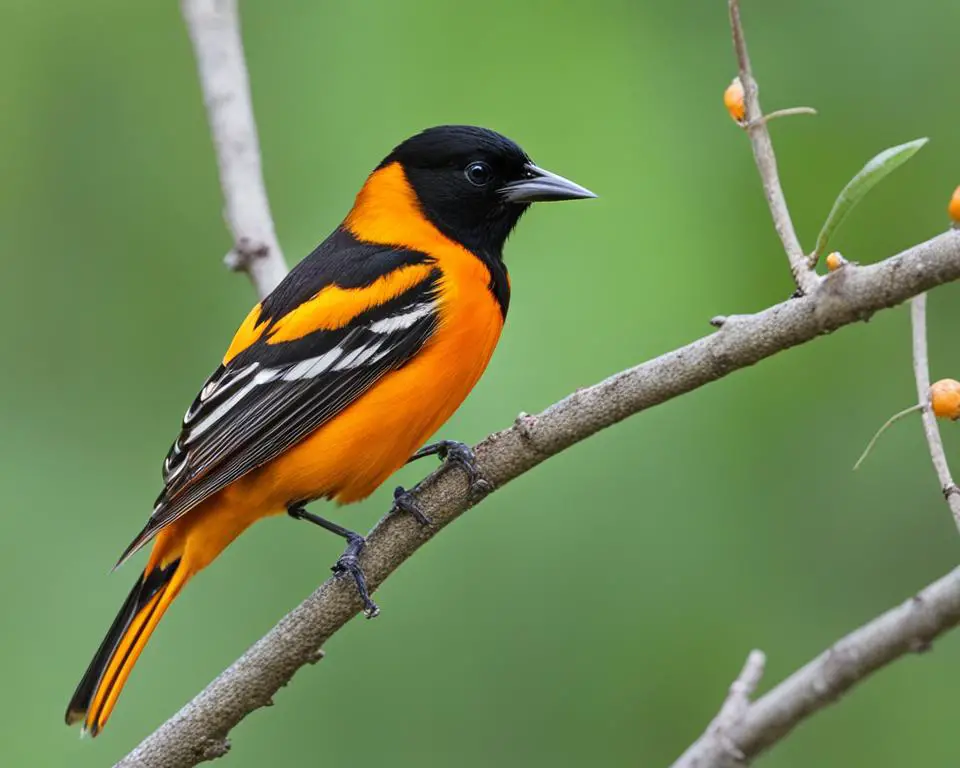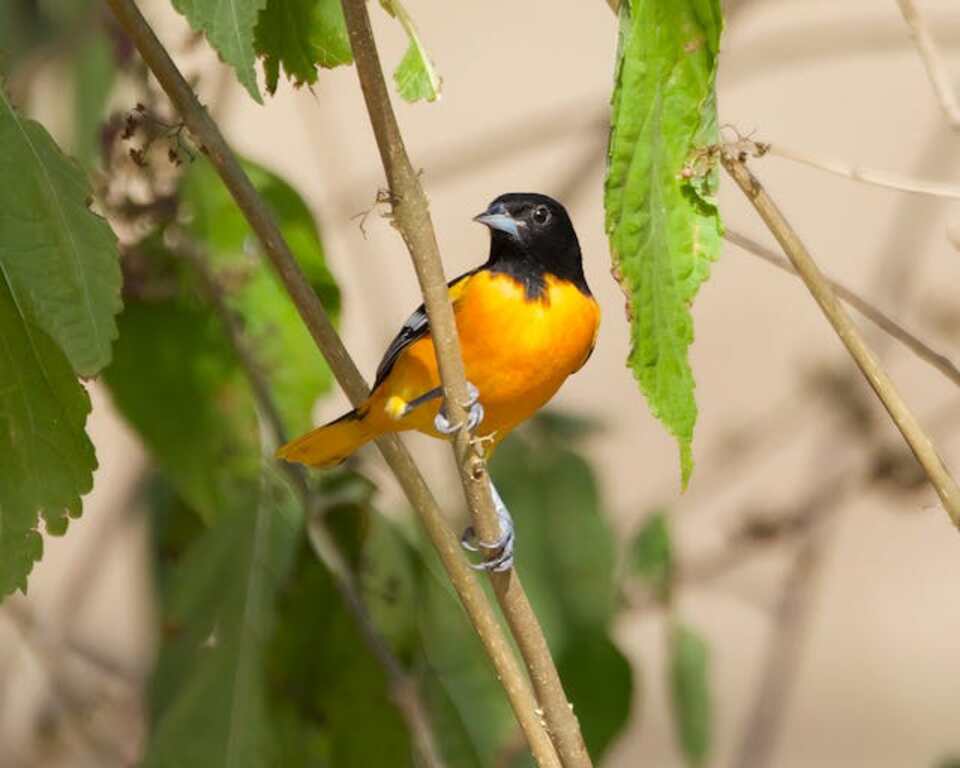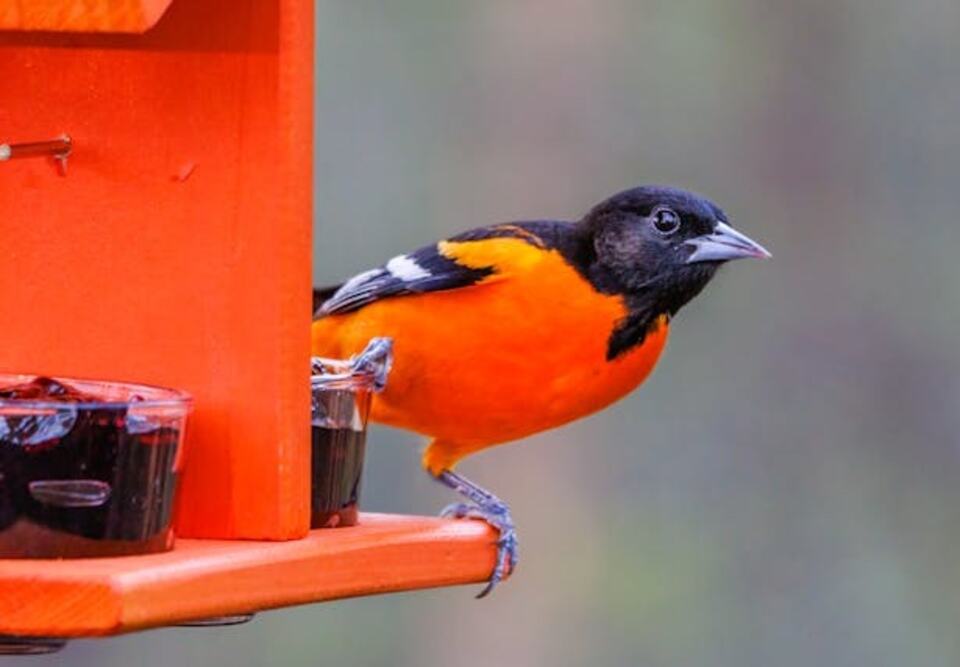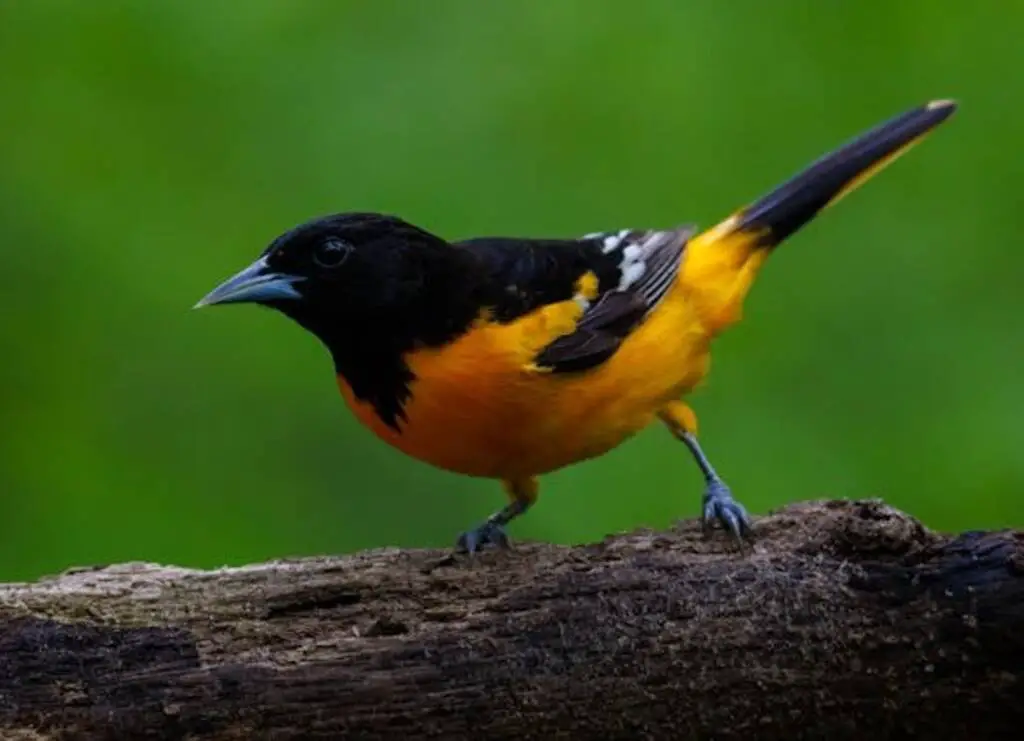The Baltimore Oriole, with its striking orange and black plumage, is a beloved bird that captures the imagination of both casual observers and dedicated ornithologists alike. This iconic species, scientifically known as Icterus galbula, is not just a symbol of spring’s arrival but also a fascinating subject of study in the world of ornithology.
In this comprehensive guide, we’ll explore every aspect of the Baltimore Oriole’s life, from its physical characteristics to its conservation status, providing you with a thorough understanding of this remarkable bird.
Table of Contents
- 1 Physical Characteristics: Nature’s Palette in Flight
- 2 Habitat: From Treetops to Backyards
- 3 Diet: A Diverse Palate
- 4 Behavior: The Art of Avian Living
- 5 Reproduction: The Cycle of Life
- 6 Conservation Status: Protecting a Backyard Favorite
- 7 Baltimore Orioles in Culture and History
- 8 Interesting Facts and Trivia
- 9 Baltimore Orioles and Climate Change
- 10 Baltimore Orioles in Urban Environments
- 11 Conclusion: The Future of Baltimore Orioles
- 12 Author
Physical Characteristics: Nature’s Palette in Flight
The Baltimore Oriole is a medium-sized songbird, known for its vibrant coloration and melodious voice. Understanding its physical attributes is crucial to appreciating its beauty and identifying it in the wild.
Size and Shape
- Length: 7-8.3 inches (17.8-21 cm)
- Wingspan: 9.1-11.8 inches (23-30 cm)
- Weight: 1.1-1.4 ounces (30-40 grams)
The Baltimore Oriole has a slender, elongated body with a long tail. Its bill is sharp and pointed, perfectly adapted for its varied diet. The bird’s overall shape is streamlined, allowing for agile flight and easy maneuvering through tree branches.
Plumage and Coloration
One of the most striking features of the Baltimore Oriole is its brilliant plumage. The coloration varies between males and females, showcasing a perfect example of sexual dimorphism in birds.
Male Baltimore Oriole:
- Head, throat, upper back, wings, and tail: Jet black
- Breast, belly, lower back, and rump: Bright orange
- White wing bars on black wings
- Orange shoulder patches
Female Baltimore Oriole:
- Overall coloration: More subdued than males
- Head and back: Olive-yellow to brownish-orange
- Breast and belly: Dull orange or yellowish
- Wings: Dark with two white wing bars
- Tail: Olive-brown
Juvenile Baltimore Orioles resemble females but have duller plumage. As they mature, males gradually develop their distinctive black and orange coloration.
Unique Features
The Baltimore Oriole’s bill is a key feature that sets it apart from other birds. It’s long, sharp, and slightly curved, perfectly adapted for probing flowers for nectar and picking insects from leaves. The bird’s feet are also noteworthy, with strong toes that allow it to perch securely on thin branches and twigs.

Habitat: From Treetops to Backyards
Understanding the Baltimore Oriole’s habitat preferences is crucial for both conservation efforts and for those hoping to attract these beautiful birds to their own yards.
Natural Habitat
Baltimore Orioles are primarily found in open woodlands, river edges, and forest margins. They show a strong preference for deciduous trees, particularly elms, maples, and cottonwoods. These birds are often spotted at the tops of tall trees, where they forage for food and build their distinctive nests.
Key habitat features include:
- Open deciduous forests
- Riparian corridors (areas along rivers and streams)
- Orchards
- Parks with scattered trees
- Suburban areas with mature trees
Geographic Range
The Baltimore Oriole’s range covers a significant portion of North America:
- Breeding Range: Eastern and central United States, southern Canada
- Winter Range: Florida, Central America, northern South America, Caribbean islands
During migration, Baltimore Orioles can be spotted in various habitats as they make their way between their breeding and wintering grounds.
Adaptation to Urban Environments
One of the fascinating aspects of the Baltimore Oriole is its ability to adapt to human-altered landscapes. These birds have successfully colonized urban and suburban areas, provided there are suitable trees for nesting and food sources available. This adaptability has made them a common sight in parks, gardens, and even city streets lined with mature trees.
Diet: A Diverse Palate
The Baltimore Oriole’s diet is as colorful as its plumage, encompassing a wide range of food sources that change with the seasons and availability.
Insectivorous Tendencies
During the breeding season, Baltimore Orioles are primarily insectivorous. Their diet consists of a variety of insects and spiders, including:
- Caterpillars (a particular favorite)
- Beetles
- Grasshoppers
- Crickets
- Ants
- Wasps
- Spiders
The birds’ sharp bills and agile movements allow them to glean insects from leaves, bark, and even in mid-air.
Fruit and Nectar
As the seasons change, Baltimore Orioles incorporate more fruit into their diet. They have a particular fondness for:
- Mulberries
- Cherries
- Grapes
- Raspberries
- Blackberries
- Bananas (in tropical wintering grounds)
Interestingly, Baltimore Orioles also feed on nectar, using their bills to probe flowers. This behavior is more common during migration and in their wintering grounds, where they visit flowering trees and vines.
Seasonal Diet Variations
| Season | Primary Diet Components |
|---|---|
| Spring | Insects, nectar |
| Summer | Insects, small fruits |
| Fall | Fruits, insects |
| Winter | Fruits, nectar, insects |
Attracting Baltimore Orioles to Feeders
For bird enthusiasts looking to attract Baltimore Orioles to their yards, offering the right foods is key:
- Orange halves: Place orange halves on platform feeders or spike them onto branches.
- Grape jelly: Offer small amounts in shallow dishes.
- Nectar: Use special oriole feeders with larger ports than hummingbird feeders.
- Mealworms: Provide live or dried mealworms to mimic their insect diet.
Remember to place feeders in open areas near trees, preferably before the orioles arrive in spring to establish your yard as a reliable food source.
Behavior: The Art of Avian Living
The behavior of the Baltimore Oriole is a fascinating aspect of its natural history, encompassing everything from its daily activities to its social interactions and unique adaptations.
Daily Routine
Baltimore Orioles are diurnal birds, active primarily during daylight hours. A typical day in the life of an oriole might look like this:
- Dawn: Begin the day with song, establishing territory or attracting mates.
- Morning: Spend time foraging for insects and fruits.
- Midday: Rest and preen, often in the shade of leafy trees.
- Afternoon: Resume foraging activities.
- Evening: Return to roosting sites, often accompanied by more singing.
Social Behavior
While Baltimore Orioles are not highly social birds outside of the breeding season, they do exhibit interesting social behaviors:
- Territorial: Males establish and defend territories during breeding season.
- Monogamous: Form pair bonds for the duration of the breeding season.
- Solitary Migrants: Travel individually or in small, loose groups during migration.
- Winter Flocking: May form small flocks with other oriole species in wintering grounds.
Vocalizations
The Baltimore Oriole’s song is one of its most distinctive features. Males are the primary singers, using their melodious whistles for territory defense and mate attraction. Their vocalizations include:
- Song: A series of rich, whistled notes, often described as “hew-li, hew-li, hew-li.”
- Call: A sharp, high-pitched “chatter” or “week” used for communication between mates or as an alarm call.
- Juvenile Begging Call: A repetitive, high-pitched chirping used by young birds to solicit food from parents.
Unique Behaviors
Several behaviors set the Baltimore Oriole apart from other bird species:
- Nest Building: Females construct intricate, hanging “sock-like” nests woven from plant fibers.
- Nectar Feeding: Use their bills to pierce the base of flowers and extract nectar, a behavior known as “nectar robbing.”
- Fruit Eating Technique: Hold fruits with their feet and use their bills to extract the pulp.
- Anting: Occasionally rub ants on their feathers, possibly to apply insect secretions that may serve as a natural pesticide.

Reproduction: The Cycle of Life
The reproductive cycle of the Baltimore Oriole is a crucial aspect of its life history, involving complex behaviors and strategies that ensure the survival of the species.
Breeding Season
The breeding season for Baltimore Orioles typically runs from late April to early July, coinciding with their return to North American breeding grounds from their wintering areas.
Key breeding season timeline:
- Arrival: Mid-April to early May
- Nest Building: May
- Egg Laying: Late May to early June
- Incubation: 12-14 days
- Nestling Period: 11-14 days
- Fledgling Care: Up to two weeks post-fledging
Courtship and Pair Formation
Baltimore Orioles engage in elaborate courtship rituals:
- Male Display: Males perform a series of bowing displays, spreading their wings and tail to showcase their vibrant plumage.
- Vocal Duets: Pairs may engage in synchronized singing, strengthening their bond.
- Chase Flights: Males pursue females through the treetops in swift, graceful flights.
- Mate Feeding: Males may offer food to females as part of the courtship process.
Nest Construction
The Baltimore Oriole’s nest is a marvel of avian architecture:
- Builder: Primarily constructed by the female, with occasional assistance from the male.
- Location: Usually placed near the end of a slender branch, 20-30 feet high in a deciduous tree.
- Structure: A hanging, sock-like pouch woven from plant fibers, grasses, and artificial materials like string or fishing line.
- Size: Typically 3-4 inches deep and 3-4 inches in diameter.
- Construction Time: 5-8 days to complete.
Egg Laying and Incubation
Once the nest is complete, the female lays a clutch of eggs:
- Clutch Size: 3-7 eggs (usually 4-5)
- Egg Color: Pale blue-gray with dark markings
- Incubation Period: 12-14 days
- Incubation Duty: Primarily performed by the female, with occasional relief from the male
Nestling Care
After hatching, both parents are involved in caring for the young:
- Feeding: Both parents feed the nestlings, primarily with insects.
- Brooding: The female broods the young for the first few days after hatching.
- Nest Sanitation: Parents remove fecal sacs to keep the nest clean.
- Nestling Period: Young remain in the nest for 11-14 days before fledging.
Fledgling Stage
Even after leaving the nest, young Baltimore Orioles continue to receive parental care:
- Duration: Parents continue to feed and protect fledglings for up to two weeks.
- Learning: Young birds learn foraging techniques from their parents during this time.
- Independence: Gradually, fledglings become more self-sufficient and eventually disperse.
Breeding Success
Several factors influence the breeding success of Baltimore Orioles:
- Predation: Eggs and nestlings may fall prey to snakes, squirrels, and other birds.
- Weather: Severe storms can destroy nests or cause nestling mortality.
- Food Availability: Abundant insect populations are crucial for nestling survival.
- Habitat Quality: Suitable nesting sites and diverse food sources contribute to successful breeding.
Conservation Status: Protecting a Backyard Favorite
Understanding the conservation status of the Baltimore Oriole is crucial for ensuring the long-term survival of this beloved species. While not currently considered globally threatened, the Baltimore Oriole faces various challenges that warrant attention and conservation efforts.
Current Population Status
According to the International Union for Conservation of Nature (IUCN), the Baltimore Oriole is classified as a species of “Least Concern.” However, this status doesn’t mean the species is free from threats or that its population is stable.
Key population statistics:
- Global Population: Estimated at 12 million individuals
- Population Trend: Slight decline (approximately 24% decrease since 1966)
- North American Breeding Bird Survey: Shows a 1.5% annual decline between 1966-2019
Threats to Baltimore Orioles
Despite their adaptability, Baltimore Orioles face several threats:
- Habitat Loss: Deforestation and urbanization in both breeding and wintering grounds reduce suitable habitats.
- Climate Change: Altering migration patterns and timing, potentially causing mismatches with food availability.
- Pesticide Use: Reduction in insect populations and potential direct toxicity to birds.
- Window Collisions: A significant cause of mortality, especially during migration.
- Predation: Increased predator populations in urban and suburban areas.
- Brood Parasitism: Occasional victims of brown-headed cowbirds, which lay eggs in oriole nests.
Conservation Efforts
Various initiatives are underway to protect Baltimore Orioles and their habitats:
- Habitat Protection: Conservation of deciduous forests and riparian areas in breeding ranges.
- Sustainable Agriculture: Promoting farming practices that reduce pesticide use and maintain hedgerows and woodland edges.
- Urban Planning: Encouraging the planting of native trees in urban and suburban areas.
- Citizen Science: Programs like eBird and Project FeederWatch help monitor population trends.
- Migration Corridor Protection: Efforts to preserve stopover sites along migration routes.
- Education: Raising awareness about the importance of orioles and how to create bird-friendly environments.
How You Can Help
Individuals can contribute to Baltimore Oriole conservation in several ways:
- Plant Native Trees: Especially elm, maple, and oak species that orioles prefer.
- Provide Food Sources: Offer nectar, fruit, and insects through appropriate feeders.
- Reduce Pesticide Use: Maintain a pesticide-free yard to support insect populations.
- Make Windows Bird-Safe: Use decals or screens to reduce window collisions.
- Participate in Citizen Science: Join bird counting projects to help monitor populations.
- Support Conservation Organizations: Donate to or volunteer with groups working to protect bird habitats.

Baltimore Orioles in Culture and History
The Baltimore Oriole holds a special place in North American culture, particularly in the state of Maryland. Its vibrant appearance and melodious song have made it a popular subject in art, literature, and even sports.
State Bird of Maryland
The Baltimore Oriole was designated as the official state bird of Maryland in 1947. This choice reflects the bird’s historical significance and its prevalence in the state. The species’ name “Baltimore” is derived from the heraldic colors of Lord Baltimore, the founder of Maryland, which match the bird’s orange and black plumage.
Sports Mascot
Perhaps the most famous cultural representation of the Baltimore Oriole is its role as the mascot and namesake of the Baltimore Orioles, a Major League Baseball team. The team’s logo features a cartoonish oriole, and their mascot, “The Oriole Bird,” is a beloved figure at games and community events.
Art and Literature
The Baltimore Oriole has inspired artists and writers for centuries:
- John James Audubon: Featured the species in his seminal work “The Birds of America.”
- Poetry: Mentioned in works by poets such as Emily Dickinson and Robert Frost.
- Folk Art: Often depicted in traditional American crafts and paintings.
Native American Lore
In some Native American traditions, the Baltimore Oriole holds symbolic significance:
- Iroquois: Believed the oriole’s song could summon rain.
- Cherokee: Considered the oriole a symbol of joy and the arrival of spring.
Scientific Impact
The Baltimore Oriole has played a role in scientific research and understanding:
- Migration Studies: Helped scientists understand long-distance bird migration patterns.
- Climate Change Research: Used as an indicator species for studying the effects of climate change on bird populations.
Interesting Facts and Trivia
To round out our comprehensive look at the Baltimore Oriole, let’s explore some fascinating facts and trivia that showcase the unique aspects of this remarkable bird.
- Nest Engineering: Baltimore Orioles are master weavers. Their hanging nests are so tightly woven that they can hold water. In fact, early American colonists nicknamed them “fire birds” and “golden robins” because their nests resembled the shape and color of ripe oranges hanging from trees.
- Artificial Fibers: These adaptable birds have been known to incorporate artificial materials like yarn, string, and even fishing line into their nests. While this shows their resourcefulness, it can sometimes lead to entanglement issues.
- Color Variation: While the typical Baltimore Oriole sports bright orange plumage, some individuals can appear more reddish or even yellow. This variation is thought to be linked to diet, particularly the amount of carotenoid pigments in the foods they consume.
- Hybridization: In areas where their ranges overlap, Baltimore Orioles sometimes hybridize with Bullock’s Orioles. These hybrids were once considered a separate species called “Northern Oriole” before genetic studies revealed their true nature.
- Longevity: The oldest recorded Baltimore Oriole in the wild lived to be 11 years and 7 months old. However, the average lifespan is typically 6-10 years.
- Fast Flyers: Despite their relatively small size, Baltimore Orioles are capable of flying at speeds up to 30 miles per hour.
- Nocturnal Migration: Like many migratory birds, Baltimore Orioles typically migrate at night. This behavior helps them avoid predators and take advantage of calmer air conditions.
- Fruit Preference: These birds show a strong preference for dark-colored fruits like purple grapes and blackberries over lighter colored options.
- Jelly Lovers: Baltimore Orioles have a well-known fondness for grape jelly, which many bird enthusiasts use to attract them to feeders. However, it’s important to offer this treat in moderation as part of a balanced diet.
- Winter Transformation: During winter in their tropical habitats, male Baltimore Orioles can sometimes be mistaken for females. This is because their bright breeding plumage becomes duller and more muted in the non-breeding season.
Baltimore Orioles and Climate Change
As we delve deeper into the 21st century, it’s crucial to understand how climate change is affecting Baltimore Orioles and what this means for their future.
Shifting Migration Patterns
One of the most noticeable impacts of climate change on Baltimore Orioles is the alteration of their migration patterns:
- Earlier Spring Arrival: Many Baltimore Orioles are now arriving at their breeding grounds earlier in the spring than they did historically.
- Later Fall Departure: Some individuals are delaying their southward migration, staying on the breeding grounds longer into the fall.
These changes can lead to potential mismatches between the birds’ lifecycle and the availability of critical resources, such as insects for feeding nestlings.
Range Expansion
Climate change is also influencing the geographic distribution of Baltimore Orioles:
- Northward Shift: The species’ breeding range is gradually moving northward as temperatures warm.
- New Habitats: Baltimore Orioles are being spotted in areas where they were previously rare or absent, particularly at higher latitudes and elevations.
While this range expansion might seem positive, it can lead to new challenges, such as competition with other species and adaptation to unfamiliar habitats.
Food Availability
Changes in temperature and precipitation patterns are affecting the availability of food sources for Baltimore Orioles:
- Insect Phenology: The timing of insect emergence is shifting, which can impact the availability of food for nestlings.
- Fruit Production: Changes in climate can affect the timing and abundance of fruit production, an important food source for orioles.
Extreme Weather Events
Climate change is increasing the frequency and intensity of extreme weather events, which can have severe impacts on Baltimore Orioles:
- Storms: More frequent and severe storms can destroy nests and cause direct mortality.
- Heat Waves: Extended periods of extreme heat can lead to nest abandonment and reduced breeding success.
- Droughts: Prolonged dry spells can reduce food availability and impact breeding success.
Conservation Implications
Understanding these climate-related challenges is crucial for developing effective conservation strategies:
- Habitat Protection: Preserving and creating diverse habitats that can provide resources under varying climate conditions.
- Connectivity: Ensuring habitat connectivity to allow for range shifts and gene flow between populations.
- Monitoring: Continued monitoring of population trends, migration timing, and breeding success to inform adaptive management strategies.
- Research: Investigating the adaptive capacity of Baltimore Orioles to climate change and identifying potential refugia.
Baltimore Orioles in Urban Environments
As human populations expand and urban areas grow, Baltimore Orioles have shown a remarkable ability to adapt to city life. Understanding their urban ecology is crucial for conservation efforts and for creating bird-friendly urban spaces.
Urban Adaptations
Baltimore Orioles have made several adaptations to thrive in urban and suburban environments:
- Diverse Nesting Sites: While they prefer tall deciduous trees, urban orioles have been known to nest in unusual locations like lamp posts or large shrubs.
- Artificial Food Sources: They readily take advantage of bird feeders, especially those offering fruit, nectar, or jelly.
- Noise Tolerance: Urban orioles have adapted their songs to be heard over city noise, often singing at higher frequencies.
- Extended Breeding Season: In some urban areas, Baltimore Orioles have been observed nesting later in the season, possibly due to artificial light and more stable food sources.
Challenges in Urban Areas
Despite their adaptability, Baltimore Orioles face several challenges in urban environments:
- Habitat Fragmentation: Urban development often results in isolated patches of suitable habitat.
- Window Collisions: Reflective glass in buildings poses a significant threat, especially during migration.
- Predation: Urban areas often have higher populations of nest predators like squirrels and crows.
- Pollution: Air and light pollution can affect oriole behavior and health.
- Non-Native Plants: Urban landscapes often feature non-native plants that may not provide suitable food or nesting materials.
Creating Oriole-Friendly Urban Spaces
Urban planners, homeowners, and community groups can take steps to make cities more hospitable for Baltimore Orioles:
- Native Plant Gardens: Encourage the planting of native trees and shrubs that provide food and nesting sites.
- Water Features: Install bird baths or small fountains to provide fresh water.
- Reduced Pesticide Use: Promote organic gardening practices to ensure a healthy insect population.
- Bird-Safe Buildings: Advocate for bird-friendly architecture, including window treatments to reduce collisions.
- Community Education: Raise awareness about urban wildlife and how to coexist with species like Baltimore Orioles.
Conclusion: The Future of Baltimore Orioles
As we’ve explored throughout this comprehensive guide, the Baltimore Oriole is a fascinating and beloved species that holds a special place in North American ecosystems and culture. From its striking appearance and melodious song to its remarkable adaptability and complex behaviors, the Baltimore Oriole continues to captivate bird enthusiasts, researchers, and casual observers alike.
Looking to the future, the Baltimore Oriole faces both challenges and opportunities. Climate change, habitat loss, and urban expansion present significant threats to the species. However, the oriole’s adaptability, coupled with increasing conservation efforts and public awareness, provides hope for its long-term survival.
Key takeaways for ensuring a bright future for Baltimore Orioles include:
- Habitat Conservation: Protecting and restoring diverse habitats, from breeding grounds to wintering areas and migration stopover sites.
- Climate Change Mitigation: Supporting broader efforts to address climate change while also focusing on climate-resilient conservation strategies.
- Urban Planning: Creating bird-friendly urban environments that provide resources for orioles and other wildlife.
- Citizen Science: Encouraging public participation in monitoring and conservation efforts to build a broader base of support and data.
- Education: Raising awareness about the ecological importance of Baltimore Orioles and the joy they bring to our lives.
By understanding and appreciating the Baltimore Oriole, we not only enrich our own lives but also contribute to the preservation of biodiversity and the health of our ecosystems. Whether you’re a seasoned birder or simply someone who enjoys the flash of orange in your backyard, every effort to support these remarkable birds makes a difference.
As we move forward, let the Baltimore Oriole serve as a vibrant reminder of the beauty and resilience of nature, inspiring us to be better stewards of the natural world. With continued research, conservation efforts, and public engagement, we can ensure that future generations will have the opportunity to marvel at the sight of a Baltimore Oriole weaving its intricate nest or hear its melodious song heralding the arrival of spring.


